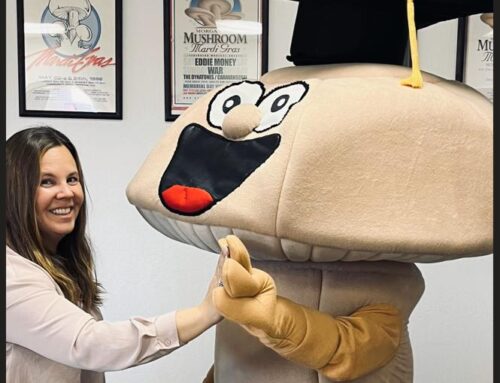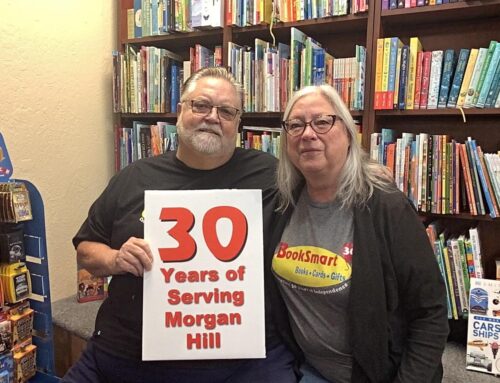School outings let youngsters don period clothing, cook and tour museum
Published in the March 30 – April 12, 2016 issue of Morgan Hill Life
By Marty Cheek

“What’s the name of that mountain over there?” she asked as she pointed at the conical-shaped peak toward the west, which helped give the estate of Diana and Hiram Morgan Hill its name.
“El Toro,” said one of the students.
“That’s right. El Toro. It means ‘the bull.’ When the Spanish explorer (Juan Bautista) de Anza rode on horses down the trail that was this road, he thought it looked like the back of a bull, so he called it ‘El Toro.’ Later it was known as ‘Murphy’s Peak’ because the Murphy family owned this land and it was left to his daughter and husband, Morgan Hill.”
The historical society started the school field trip program in 2010, with tours given to small groups in October as well as from March through May. Every year, about 900 people — students accompanied by parents and teachers — go through the tours and interactive learning where they discover facts about local history and the various people who once made their homes in the Morgan Hill area.

Another group goes through the circular maze of the “Centennial History Trail” placed in the middle of the rose garden. They learn from the docent how Native Americans came to the region about 4,000 years ago, and follow the timeline of important local events.
A third group gathers in the kitchen of the Morgan Hill House and learns how the aristocratic Diana and Hiram Morgan Hill back in the Victorian period of the late 1800s hired servants to prepare their food and take care of their clothes and other needs. The children put on aprons and worked with two docents making scones for a proper English tea. As the sweet cakes bake in the oven, the students don formal hats and coats and take a tour of the house, learning about the Hill family. When the scones are ready, the students receive an etiquette lesson from Rodriques.
In the beginning

Hennessey recalled how she told Bonfante-Johnson that she might not be prepared to take youngsters on the history walk and explain the various events in Morgan Hill’s past.
“Loritta would say, ‘Just do it, Teri,’ but I didn’t know what I was doing. So Margaret and the rest of us docents decided to write a detailed training manual from set up, what you have to do, and Core standards for all of the teachers. In the third, fourth and fifth grades, they have to follow the curriculum in the program, otherwise the teachers won’t come.”
The costume changes for the students, where they become “actors” pretending to live in the past, is a big hit, she said. Money for the costumes and props came from a grant from the Live Oak Foundation. The children also enjoy playing “detective,” looking for clues about the Morgan Hill House and its gardens and figuring out what might have been there in the past. A history-oriented scavenger hunt is also fun for the students to search for various artifacts.
The field trip program is designed to help children see what was happening in the sleepy village of Morgan Hill in the context of United States history such as more people coming by train to California and the South Valley to farm on the land here in the decades after the American Civil War.
“It’s very detailed,” Hennessey said. “Loritta and Margaret put me in the history trail because I’m a hyper gal and have a lot of energy. When I do the tours, I try to incorporate ideas to make students think about things, such as what was it like in the house when it was first built. I try to get students to think what it might be life to be a pioneer in the wilderness. What do you have to do when you’re on the trail?”
Rodrigues has a passion for education and for history, which led her to be part of the historical society team that developed the field trip program. She taught in Morgan Hill elementary schools for almost 39 years. When she retired in 2010, she realized she could continue her passion for local history and teaching it to kids by organizing field trips at Villa Mira Monte.
“Jennifer Tate was on the historical society’s board of directors with Loritta and they had talked about doing an educational outreach,” she said. “They wanted something to help build up the museum, but also have the people of Morgan Hill know what was going on here. Being a teacher, I had been to other museums with kids, so I knew what was going on.”
Children help design program

“They were really instrumental,” Rodriques said. “They told us, ‘Do not just take them on the tour. They need to be living it.’ They were in third grade and sixth grade at the time, and they had just experienced three weeks of museums back in Washington, D.C., and New York and (colonial) Williamsburg, Virginia. And they said the one that meant the most to them was Williamsburg because they got to put on costumes, and had little messages where they went place to place and interacted such as planting a garden.”
Tate wanted the Victorian era to come to life in the field trip program. That’s why the docents emphasize that the Hill family were different from the other people who lived in the South Valley because they really brought an upper-class, gentry-style to the town. The Queen Anne-style home they built on Villa Mira Monte was a “vacation” home where they could take the train from San Francisco and get off when it stopped at the house’s backyard, Rodriques said.
As part of its local school education program, the historical society is planning to put together a collection of “history trunks” which can be borrowed by the school teachers in the Morgan Hill Unified School District. These trunks will be filled with items relating to the Native American Amah Mutsun tribe who lived in the area when the Spanish came. The children will learn that the California Indians were very peaceful and lived lives very different from the tribes in the Great Plains, which most people usually think of as Indian culture.
“They didn’t have buffalo and live in tepees. They actually were migrational farmers,” Rodriques said.
Most fourth-grade teachers focus on the Spanish missionary story when teaching California history, but often neglect telling the Indian’s side of the story, so that’s why the history trunk program is being developed, she said.
“A school will have it for a month where the teachers would have the material to work with and then return it to the museum to go to the next school,” she said.
Students enjoy trips
The Paradise Valley students were enchanted by their four-hour Villa Mira Monte field trip.
Third-grader Julie Duran beamed with a big smile as she described how the experience helped her to have insight into the people who lived in the home more than 100 years ago.
“I liked it. It was very educational,” she said.
Student Jayden Mann said learning about the pioneer days helped him see his own 21st century Morgan Hill world a bit differently.
“We got to see all the different things about Morgan Hill,” he said. “We’re learning about what people did in the past and comparing the past and now. Back then they didn’t have technology, they didn’t have phones, and now we have a lot of technology and phones and our houses are bigger.”
Paradise Valley student Ashley Peterson said she better appreciates today’s modern conveniences and high-tech gadgets after learning how children in the past did not have such devices that are common today.
“What we learned was things about the past and that now we have more stuff and we’re just happy that we get to live in this life now instead of back then,” she said.
Jean Mason, the third-grade teacher with the Paradise Valley Elementary School class on the field trip, was impressed at how much thought has gone into the program to follow Common Core curriculum in not just history but also science. The students will prepare a report about their experience later, she said, reinforcing what they learned by sharing their experience through the written word and a oral presentation.
“The kids get a lot out of it because in the third grade this is definitely their curriculum — the Morgan Hill history and how it has changed from then to now,” she said. “At Paradise Valley, we put technology into the experience so they do slide shows, they create a movie, they do a Morgan Hill map and a Morgan Hill scrap book so this really ties into what they are learn.”
The school field trip program that the Morgan Hill Historical Society has developed definitely is a worthwhile resource for teachers to help students discover directly through hands-on experience what life was like long ago, she said.
“Since there’s limited resources (for schools), this is definitely a great resource, and they get to see everything and make their cookies and stuff,” she said. “It’s definitely much more real for the kids.”






